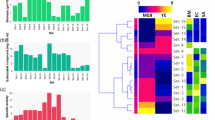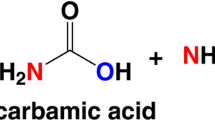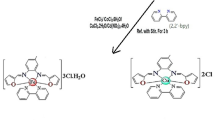Abstract
IN a previous communication1 on the mode of fungitoxic action on Aspergillus niger, we found that of the copper complexes of 8-hydroxyquinoline (oxine) and pyridine-N-oxide-2-thiol (PTO), the 1 : 2 complexes are toxic, but of the sodium dimethyl-dithiocarbamates (NaDDC) the 1 : 1 complex is toxic but 1 : 2 complex is not. We suggested that this discrepancy is not fundamental but can be explained simply by the difference in solubility of the complexes (Table 1). This hypothesis can now be substantiated by observations on the fungitoxic action on Glomerella cingulata, a more sensitive mould than A. niger. The experiments were carried out as described before1, in shaken flasks with a basal medium of glass distilled water and analytical grade reagents, the total copper content not exceeding the equivalent of 0.01 p.p.m. CuSO4.5H2O. We found that, unlike A. niger, Glomerella cingulata does not show ‘inversion growth’ with sodium dimethyl-dithiocarbamate and copper and, as could be expected on this ground, it is inhibited by copper dimethyldithiocarbamate (CuDDC2) (Table 1). The toxic concentration of copper dimethyldithiocarbamate appeared to be somewhat higher than the concentration of a saturated solution2, but this can be easily understood since the dissolution is a rather slow process. From Table 1 it follows that for all three 1 : 2 complexes G. cingulata is more sensitive than A. niger.
This is a preview of subscription content, access via your institution
Access options
Subscribe to this journal
Receive 51 print issues and online access
$199.00 per year
only $3.90 per issue
Buy this article
- Purchase on Springer Link
- Instant access to full article PDF
Prices may be subject to local taxes which are calculated during checkout
Similar content being viewed by others
References
Sijpesteijn, A. Kaars, Janssen, M. J., and Dekhuijzen, H. M., Nature, 180, 505 (1957).
Janssen, M. J., Ricerca Sci. (in the press).
Janssen, M. J., Rec. trav. chim., 76, 827 (1957).
Albert, A., Rees, C. W., and Tomlinson, A. J. H., Brit. J. Exp. Path., 37, 500 (1956). Albert, A., in “The Strategy of Chemotherapy”, ed. Cowan, S. T., and Rowatt, E. (Cambridge, 1958).
Anderson, B. I., and Swaby, R. J., Austral. J. Sci. Res., B, 4, 175 (1951).
Author information
Authors and Affiliations
Rights and permissions
About this article
Cite this article
SIJPESTEIJN, A., JANSSEN, M. Fungitoxic Action of 8-Hydroxyquinoline, Pyridine-N-oxide-2-thiol and Sodium Dialkyl-dithiocarbamates, and their Copper Complexes. Nature 182, 1313–1314 (1958). https://doi.org/10.1038/1821313a0
Issue Date:
DOI: https://doi.org/10.1038/1821313a0
This article is cited by
-
The systemic action of dimethyldithilocarbamates on cucumber scab caused byCladosporium cucumerinum and the conversion of these compounds by plants
Netherlands Journal of Plant Pathology (1964)
-
Transformation in Plants of Sodium Dimethyldithiocarbamate into other Fungitoxic Compounds
Nature (1961)
-
On the mode of action of dialkyldithiocarbamates on moulds and bacteria
Antonie van Leeuwenhoek (1959)
Comments
By submitting a comment you agree to abide by our Terms and Community Guidelines. If you find something abusive or that does not comply with our terms or guidelines please flag it as inappropriate.



